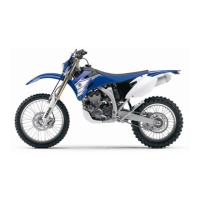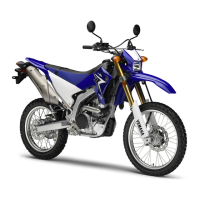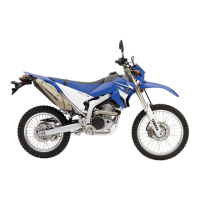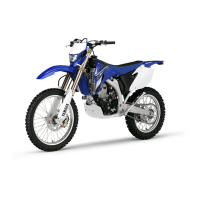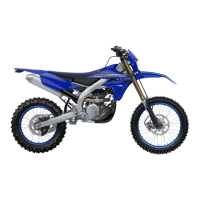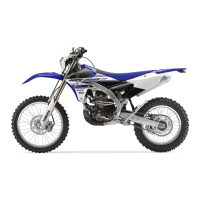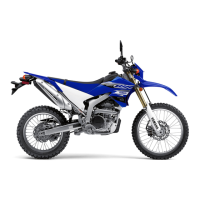Do you have a question about the Yamaha WR250X and is the answer not in the manual?
Critical safety preamble for operating the motorcycle.
Explains symbols and terms used throughout the manual.
Emphasizes owner's responsibility and safe operation practices.
Details essential rider gear and carbon monoxide risks.
Guidelines on vehicle load capacity and accessory usage.
Warnings on aftermarket parts and safe motorcycle transport.
Illustrates and labels key motorcycle parts in a left-side view.
Illustrates and labels key motorcycle parts in a right-side view.
Shows the layout of handlebar controls and dashboard instruments.
Explains the functions of the ignition and steering lock.
Describes the meaning and function of dashboard indicator lights.
Details the usage and features of the digital multi-function display.
Explains the operation of switches on the left and right handlebars.
Describes the operation of the shift pedal, brake lever, and brake pedal.
Covers fuel cap usage and safe refueling practices.
Information on the catalytic converter and seat maintenance.
Details helmet holder use and front fork damping adjustments.
Steps for bleeding air from the front forks.
Explains adjustments for rear suspension preload and damping.
Covers sidestand operation and safety interlock system functions.
Comprehensive list of checks before operating the vehicle.
Step-by-step guide for safely starting the motorcycle engine.
Explains gear shifting and finding neutral.
Advice to reduce fuel use and crucial break-in procedures.
Guidelines for safe parking to prevent hazards.
Explains benefits of maintenance for safety and efficiency.
Lists tools provided and their use for minor repairs.
Schedule for emission control system checks and services.
Schedule for routine maintenance and lubrication tasks.
Instructions for removing and refitting body panels for maintenance.
Guide to checking spark plug condition, gap, and replacement.
Procedures for checking oil level and changing oil/filter.
How to check coolant level and perform coolant changes.
Steps for cleaning the air filter and checking the associated hose.
Adjusting engine idle speed and checking throttle grip free play.
Details valve clearance checks and tire specifications.
Specifics on maintaining spoke wheels and avoiding tubeless tires.
How to adjust the clutch lever free play for proper operation.
How to adjust the brake lever free play for optimal braking.
Checking shift pedal, brake light switches, and brake pad wear.
Crucial steps for checking brake fluid level and related safety precautions.
Procedures for changing brake fluid and adjusting drive chain slack.
Maintaining the drive chain and checking control cables.
Lubricating throttle controls and brake/clutch levers.
Maintenance of brake pedal, sidestand, and swingarm pivots.
Inspecting front fork condition/operation and steering bearing wear.
Checking wheel bearings and basic battery maintenance.
Procedures for replacing fuses and storing the battery.
Step-by-step guide for replacing the headlight bulb.
Information on LED tail light and turn signal bulb replacement.
Procedures for replacing license plate and auxiliary light bulbs.
Safety for supporting the bike and removing the front wheel.
Procedures for rear wheel removal and safety precautions.
Overview of troubleshooting procedures for common issues.
Diagnostic flowcharts for starting problems and engine performance.
Steps to diagnose and address engine overheating.
General guidelines for cleaning and maintaining the motorcycle.
Instructions for short-term and long-term storage of the vehicle.
Technical specifications for dimensions, engine, and fluids.
Details on bulbs, fuses, and electrical components.
Location and importance of VIN and model label.
Critical safety preamble for operating the motorcycle.
Explains symbols and terms used throughout the manual.
Emphasizes owner's responsibility and safe operation practices.
Details essential rider gear and carbon monoxide risks.
Guidelines on vehicle load capacity and accessory usage.
Warnings on aftermarket parts and safe motorcycle transport.
Illustrates and labels key motorcycle parts in a left-side view.
Illustrates and labels key motorcycle parts in a right-side view.
Shows the layout of handlebar controls and dashboard instruments.
Explains the functions of the ignition and steering lock.
Describes the meaning and function of dashboard indicator lights.
Details the usage and features of the digital multi-function display.
Explains the operation of switches on the left and right handlebars.
Describes the operation of the shift pedal, brake lever, and brake pedal.
Covers fuel cap usage and safe refueling practices.
Information on the catalytic converter and seat maintenance.
Details helmet holder use and front fork damping adjustments.
Steps for bleeding air from the front forks.
Explains adjustments for rear suspension preload and damping.
Covers sidestand operation and safety interlock system functions.
Comprehensive list of checks before operating the vehicle.
Step-by-step guide for safely starting the motorcycle engine.
Explains gear shifting and finding neutral.
Advice to reduce fuel use and crucial break-in procedures.
Guidelines for safe parking to prevent hazards.
Explains benefits of maintenance for safety and efficiency.
Lists tools provided and their use for minor repairs.
Schedule for emission control system checks and services.
Schedule for routine maintenance and lubrication tasks.
Instructions for removing and refitting body panels for maintenance.
Guide to checking spark plug condition, gap, and replacement.
Procedures for checking oil level and changing oil/filter.
How to check coolant level and perform coolant changes.
Steps for cleaning the air filter and checking the associated hose.
Adjusting engine idle speed and checking throttle grip free play.
Details valve clearance checks and tire specifications.
Specifics on maintaining spoke wheels and avoiding tubeless tires.
How to adjust the clutch lever free play for proper operation.
How to adjust the brake lever free play for optimal braking.
Checking shift pedal, brake light switches, and brake pad wear.
Crucial steps for checking brake fluid level and related safety precautions.
Procedures for changing brake fluid and adjusting drive chain slack.
Maintaining the drive chain and checking control cables.
Lubricating throttle controls and brake/clutch levers.
Maintenance of brake pedal, sidestand, and swingarm pivots.
Inspecting front fork condition/operation and steering bearing wear.
Checking wheel bearings and basic battery maintenance.
Procedures for replacing fuses and storing the battery.
Step-by-step guide for replacing the headlight bulb.
Information on LED tail light and turn signal bulb replacement.
Procedures for replacing license plate and auxiliary light bulbs.
Safety for supporting the bike and removing the front wheel.
Procedures for rear wheel removal and safety precautions.
Overview of troubleshooting procedures for common issues.
Diagnostic flowcharts for starting problems and engine performance.
Steps to diagnose and address engine overheating.
General guidelines for cleaning and maintaining the motorcycle.
Instructions for short-term and long-term storage of the vehicle.
Technical specifications for dimensions, engine, and fluids.
Details on bulbs, fuses, and electrical components.
Location and importance of VIN and model label.
| Displacement | 250cc |
|---|---|
| Bore x Stroke | 77.0mm x 53.6mm |
| Compression Ratio | 11.8:1 |
| Fuel System | Fuel Injection |
| Final Drive | Chain |
| Front Tire | 110/70-17 |
| Rear Tire | 140/70-17 |
| Seat Height | 35.2 in |
| Fuel Capacity | 2.0 gal |
| Engine Type | Liquid-cooled DOHC 4-stroke; 4 valves |
| Ignition | TCI (Transistor Controlled Ignition) |
| Front Suspension | Inverted fork |
| Rear Suspension | Single shock |
| Front Brake | 298mm hydraulic disc |
| Rear Brake | 230mm hydraulic disc |
| Transmission | 6-speed |


